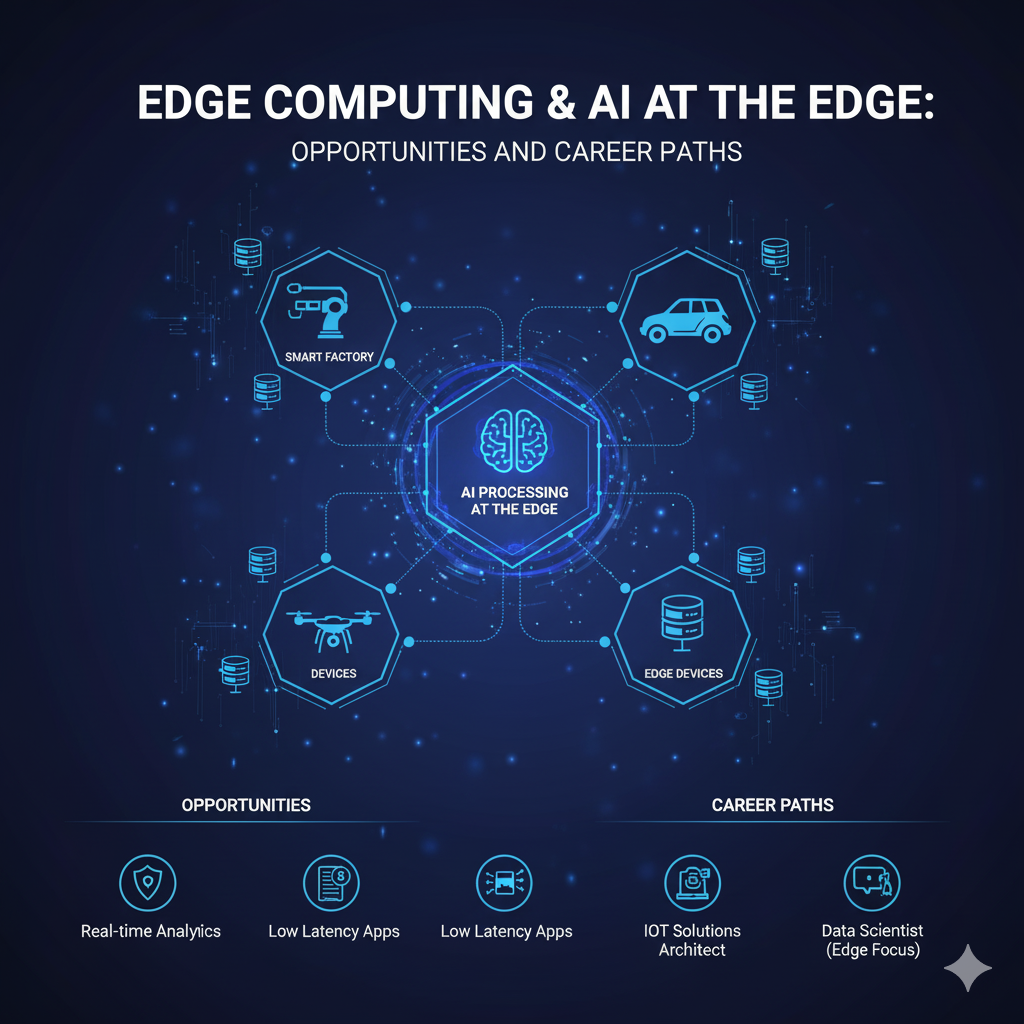
Edge Computing & AI at the Edge: Opportunities and Career Paths
As the Internet of Things (IoT) proliferates and devices generate ever more data, edge computing combined with AI at the edge is no longer a futuristic concept—it’s becoming a necessity. In 2025, the trade-offs of latency, bandwidth, and data privacy are driving adoption of architectures where intelligence is pushed closer to the device. For tech professionals, this presents exciting new career paths—if you know where to look.
🌍 What Is Edge Computing & AI at the Edge?Edge computing brings compute, storage, and processing closer to the data source—on devices, gateways, or local nodes—rather than routing everything to distant cloud servers. Edge AI (or AI at the edge) refers to deploying machine learning inference or decision logic locally so systems can act in real time without relying on round-trip communication to the cloud.
This approach delivers faster responses, lower bandwidth usage, and improved privacy. For example, deploying TinyML models on microcontrollers in resource-limited environments allows on-device inference. Datacamp’s introduction to TinyML explains how models optimized for memory and energy constraints make edge AI feasible. (Datacamp: What Is TinyML?)
Research also shows how TinyML is used in industrial settings (e.g. for robotic arm control) to reduce latency and energy cost. (MDPI: Integrating Tiny Machine Learning and Edge Computing)
Additionally, a survey on Edge AI highlights architectures, model strategies, and deployment constraints in real-world IoT systems. (ScienceDirect: Edge AI survey)
📈 Key Trends & Drivers in 2025Several forces are accelerating the adoption of edge + AI architectures:
-
Latency-sensitive applications: Autonomous systems, industrial automation, AR/VR, and medical devices require near-instant responses.
-
Data volume & bandwidth constraints: Streaming raw sensor or video data to the cloud is costly and sometimes impractical.
-
Privacy & data sovereignty: Local processing helps in complying with data protection regulations and minimizing risk exposure.
-
Model optimization advances: Techniques like quantization, pruning, and compact neural architectures make AI inference on edge hardware viable.
-
Hybrid edge-cloud orchestration: Modern systems deploy compute across edge and cloud environments, deciding what logic lives where.
-
5G / MEC (Multi-Access Edge Computing): Telecom operators are deploying compute at network edges, enabling ultra-low latency services.
In Embedded World 2024, analysts noted that TinyML (AI at the edge) is increasingly integrated into everyday devices to handle decision-making autonomously. (IoT Analytics: Top 6 Edge AI Trends)
🛠 Essential Skills & Technologies for Edge AI ExpertsTo compete in this domain, professionals need a hybrid skill set spanning hardware, software, AI, and systems thinking:
-
Embedded Systems & Hardware Interface: Interacting with sensors, microcontrollers, low-level firmware, and real-time operating systems.
-
Edge AI / Model Optimization: Use frameworks like TensorFlow Lite Micro, PyTorch Mobile; apply quantization, pruning, model splitting.
-
IoT Protocols & Connectivity: Master MQTT, CoAP, BLE, LoRaWAN, and handle intermittent connectivity.
-
Real-Time Data Processing / Streaming: Local aggregation, triggering, stream analytics frameworks.
-
Security & Privacy in Edge Environments: Secure boot, firmware integrity, encryption, local data governance.
-
Hybrid Architecture & Edge-Cloud Integration: Design workflows that sync, fallback, and balance compute between edge and cloud.
-
Networking, 5G & MEC: Understand network slices, QoS, edge node placement.
-
Soft Skills & System Design Thinking: Bridge device-level constraints, cloud infrastructure, and functional requirements.
Articles exploring Tiny Deep Learning describe how compressed models are now pushing beyond TinyML to more capable edge deployments. (TinyDL Survey)
Deploying deep learning models on edge platforms is also explored via frameworks such as MATLAB and Simulink for proof-of-concept edge AI systems. (MathWorks: Rapid Deep Learning Deployment on Edge)
🚀 Emerging Career Paths & RolesHere are several roles that are gaining traction in the edge + AI domain:
-
Edge AI Engineer / Developer – Build, optimize, and deploy inference models on edge hardware.
-
IoT / Edge Systems Architect – Architect end-to-end solutions from sensors to cloud, deciding where each logic block should run.
-
Edge Security Specialist – Harden edge devices, manage identity, encryption, secure updates.
-
Hybrid Edge-Cloud Integration Engineer – Manage synchronization, orchestrate workloads between edge and cloud tiers.
-
5G / MEC / Network Edge Engineer – Deploy infrastructure supporting low-latency edge compute.
-
Real-Time Analytics / Stream Engineer – Implement triggers, local decisioning, anomaly detection at the device level.
Refonte Learning reports that by 2025, roles like Edge AI Developer, Edge Computing Engineer, and hybrid solutions engineers are among the fastest-growing segments for tech professionals. (Refonte Learning: Top Careers in Edge Computing & AI in 2025)
Moreover, job boards like Indeed list over 7,000+ edge computing jobs, signaling demand. (Indeed: Edge Computing Jobs)
💡 How ChronoLearn Can Help You Get Edge-ReadyAt ChronoLearn, we design our technology training programs to align with emerging domains like edge AI:
-
AI & Data Analytics Courses – Including modules on inference, model compression, and edge deployment.
-
Cloud & Edge Integration Programs – Teaching hybrid architectures, synchronization strategies, fallback logic.
-
Security & Privacy Compliance Tracks – Securing device-to-server pathways, data privacy at the edge, firmware integrity.
By combining these, you can build a portfolio of edge AI projects and position yourself for high-demand roles.
✅ Final ThoughtsEdge computing and AI at the edge are redefining how systems are built. Decisions once reserved for large data centers are now migrating to devices. For professionals, mastering embedded systems, model optimization, hybrid orchestration, and security is no longer optional—it’s essential for career longevity.
The future is intelligent devices, powered by AI and designed pragmatically across edge and cloud. Start building those cross-domain skills now—and let ChronoLearn guide your journey.
👉 Explore our AI & Data Analytics page for more details and course enrollment.
Tags :
- Edge Computing
- Edge AI
- Artificial Intelligence
- IoT
- Cloud Computing
- 5G
- TinyML
- AI Careers
- ChronoLearn
- Data Processing
- Edge computing and AI career opportunities 2025
- What is AI at the edge and why it matters
- IoT and edge computing jobs
- Edge AI training courses online
- How to build a career in edge computing
- Edge vs Cloud computing performance
- Future of AI and IoT integration
- Edge computing and data privacy
- Top edge AI tools and frameworks
- ChronoLearn AI and Cloud courses






